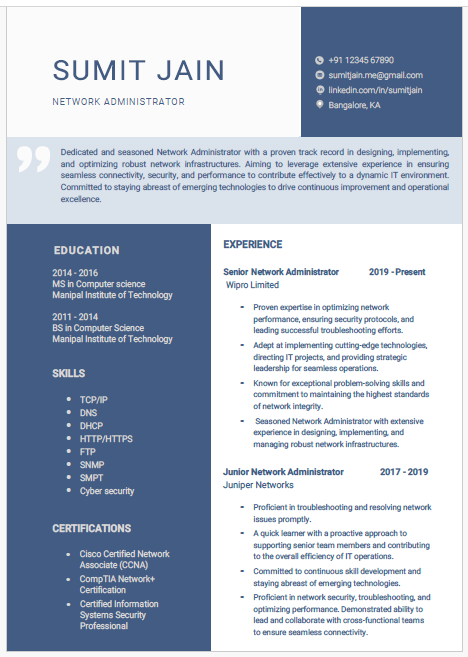Network Administrator
MS in Computer science

About this template
This is very beautiful and eye catching resume format.
Freshers and Experienced both candidates can use this template. This template is created in Microsoft word. So users can easily modify this as per their need and requirements.
Some Useful and Common Interview question answers for Network administrator
Here are some useful and common interview questions for a network administrator, along with suggested answers :
1. Can you describe your experience with network design and implementation?
Answer : I have extensive experience designing and implementing networks, including both LAN and WAN configurations. In my previous role at [Previous Company], I designed a scalable network architecture to support growing business needs. This involved setting up routers, switches, and firewalls, as well as configuring VLANs and VPNs for secure remote access. I also ensured that the network design adhered to industry best practices and met the company's performance and security requirements.
2. How do you troubleshoot network connectivity issues?
Answer : When troubleshooting network connectivity issues, I follow a systematic approach. I start by checking physical connections and hardware to ensure everything is plugged in and functioning. Next, I use tools like ping and tracert to identify where the connection fails. I also check network configurations and settings, such as IP addresses and subnet masks, to ensure they are correct. Additionally, I review logs and use diagnostic tools like Wireshark to analyze network traffic and pinpoint issues.
3. What is your experience with network security measures?
Answer : I have experience implementing various network security measures, including configuring firewalls, intrusion detection systems (IDS), and intrusion prevention systems (IPS). I also manage access control lists (ACLs) and set up secure VPN connections to protect sensitive data. Regular security audits and updates to network devices are part of my routine to ensure vulnerabilities are addressed promptly. Additionally, I stay informed about the latest security threats and best practices to protect the network from emerging risks.
4. Can you explain the difference between TCP and UDP?
Answer : TCP (Transmission Control Protocol) and UDP (User Datagram Protocol) are both transport layer protocols but serve different purposes. TCP is connection-oriented and provides reliable, ordered, and error-checked delivery of data. It ensures that data packets are received in the correct order and retransmits any lost packets. UDP, on the other hand, is connectionless and does not guarantee delivery, order, or error-checking. It is used for applications where speed is more critical than reliability, such as streaming services or online gaming.
5. How do you handle network performance issues?
Answer : To address network performance issues, I first gather performance data using tools like SNMP, NetFlow, or network monitoring software. I look for signs of congestion, such as high bandwidth usage or latency spikes. I then analyze the data to identify bottlenecks or misconfigurations. Solutions may include optimizing network paths, upgrading hardware, or adjusting QoS (Quality of Service) settings to prioritize critical traffic. Regular network performance reviews and tuning are also part of my strategy to maintain optimal performance.
6. What is your experience with network monitoring tools?
Answer : I have experience using various network monitoring tools such as Nagios, SolarWinds, and PRTG. These tools help me monitor network performance, detect issues, and generate alerts for anomalies. I use them to track metrics like bandwidth usage, network uptime, and device health. By analyzing the data provided by these tools, I can proactively address potential problems and ensure network stability.
7. How do you stay updated with the latest networking technologies and trends?
Answer : I stay updated with the latest networking technologies and trends by subscribing to industry publications, attending webinars, and participating in professional forums. I also take advantage of online courses and certifications to deepen my knowledge and skills. Networking events and conferences are valuable for learning about emerging technologies and best practices from industry experts.
8. Can you provide an example of a challenging network problem you resolved?
Answer : One challenging issue I encountered was a network outage affecting multiple departments. After initial checks, I used network monitoring tools to identify a failing switch causing a network loop. I quickly isolated the affected switch and replaced it, then adjusted the network configuration to prevent future loops. I also reviewed network topology and implemented additional safeguards to enhance reliability. The resolution minimized downtime and restored connectivity, and I documented the incident to improve our response procedures.
conclusion
These answers cover various aspects of network administration, from technical skills and problem-solving to staying updated with industry trends. Tailoring your responses with specific examples from your experience can further strengthen your interview performance.